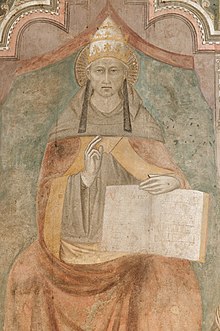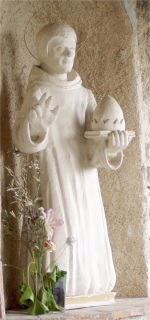Celestine V.

Celestine V (originally Pietro da Morrone , Petrus de Murrone or Pietro Angelari , * around 1209/1210 (according to other sources around 1215) in Sant'Angelo Limosano ; † May 19, 1296 in Fumone ) was a hermit , founder of the Cölestine order and of July to December 1294 Pope . He is one of the patron saints of the city of L'Aquila and the bookbinder ; May 19th is dedicated to him in the calendar of saints .
hermit
Pietro was born in Isernia between 1209 and 1215 as the second youngest of twelve children of a farming family in Abruzzo . The names Angelerius and Maria have been passed down from his parents; he lost his father at the age of six. At the age of twelve he entered the Benedictine monastery of Santa Maria de Faifula , later he lived as a hermit in the almost inaccessible Majella Mountains . After his ordination he moved into a hermitage on Monte Morrone near Sulmona and called himself "Pietro da Morrone".
His penitent life brought him numerous followers over the years, who also settled in the area as hermits. For them he founded a congregation , which he committed to a more stringent Benedictine rule. This order was named “Hermit of St. Damian ”or“ Einsiedler vom Murrone ”, later renamed the Cölestiner .
In 1274, Pietro went to the Council of Lyons, where he was recognized by his order. On the way back he spent the night on the Collemaggio hill in front of L'Aquila and there, in a dream, received instructions to build the church of Santa Maria di Collemaggio . Two years later (1276) he became abbot of Santa Maria di Faifoli and in 1278 also abbot of San Giovanni in Piano near Lucera . From 1287 the order was organized along the lines of the Cistercians . In 1293 he gave up the management and retired to his hermitage on Mount Murrone. At that time, Pietro was already venerated as a living saint .
Pope election and pontificate
The death of Pope Nicholas IV in 1292 was followed by a two-year vacancy , caused by an epidemic in Rome and irreconcilable parties in the electoral body. The last papal election , which did not take the form of a conclave , was to last two years. In the electoral committee, which was relocated to Perugia and initially had twelve members and ended with only nine, the Roman noble families of Colonna and Orsini, who were enemies of Ghibellinism and Guelfinism , faced each other. The Colonna supported the emperor, while the Orsini supported the papacy.
As a compromise candidate, unaffected by the disputes, Pietro da Morrone was brought up for discussion by King Charles II of Anjou , supported by Cardinal Latino Malabranca . The almost 85-year-old hermit had a reputation for holiness; He must have become known through a letter to the assembled cardinals, which he had written as the head of his Benedictine congregation and in which he asked them to finally vote. On July 5, 1294, Pietro da Murrone was finally elected Pope in an inspirational election, perhaps as a punishment for the letter.
When the message of his election as Pope was brought to him, Pietro initially refused and fled, but finally, with serious misgivings, allowed himself to be changed and accepted the election. Following the example of Christ on Palm Sunday , he rode on a donkey to the city of L'Aquila on July 28, 1294 , where he took the name Celestine V and in the church of Santa Maria di Collemaggio, which he founded and which was now the main church of his order , was crowned on August 29th. He never set foot in Rome.
His entry on the donkey reminded many of the promises of Joachim of Fiore that an age of the Holy Spirit would dawn. Celestine was hopelessly overwhelmed in his office and soon became politically dependent on Charles II, who brought him to Naples . In Castelnuovo a wooden he was monk's cell built where he lived, as he rejected the luxurious lifestyle of his predecessors and a return of the Church of Jesus hoped doctrine of a life in modesty and material poverty.
However, Coelestin's experience as Prior of the Order of Coelestins was not enough to lead the Church. The rulership soon slipped from the hands of the old, unprepared and poorly educated hermit, who only knew Latin from the Bible and the liturgy. It was increasingly exercised by his advisor, Cardinal Benedetto Caetani (later Pope Boniface VIII). In agony of conscience, Celestine had cardinals and canonists check whether a resignation from the papacy would be permissible. Against his better judgment, Caetani brought up legendary cases of abdication. That convinced the Pope.
abdication
On December 13, 1294, he abdicated despite considerable opposition from those around him. As reasons for his resignation , he cited illness, ignorance (no experience in the administration of the Curia) and the desire to live as a hermit again . Church historians assume that the influence of Charles II of Naples became too great for him after he had moved his official residence to Naples. It was Cardinal Caetani, who ruled the Curia, who also wrote the deed of abdication.
Previously, Celestine had passed a constitution on the abdication of a pope. He saw himself prompted by the resistance of the people, who wanted to prevent his resignation with a demonstration in front of the official residence of the Pope. But it was only delayed by seven days. After the constitution was passed, Celestine laid down the papal insignia and exchanged the papal robes again for the monk's robe.
According to tradition, Caetani was involved in an intrigue. On three consecutive nights he is said to have called to the sleeper through a hole in the wall of the papal bedroom: “Celestine, Celestine, thank you! The office is too difficult for your shoulders! ”Coelestin, who interpreted these words - comparable to the dream of the nursing father Joseph - as a whispering of the Holy Spirit, decided to resign.
Benedetto Caetani, who as Pope Boniface VIII and favorite of Charles II became Coelestin's successor, wanted to take him into custody after his abdication in order to prevent a schism . However, Coelestin was able to escape during its transfer to Naples and fled via Sant'Onofrio to Rodi Garganico , from where he wanted to reach Greece by ship. However , the shipwreck suffered near Vieste led to his arrest. Boniface had him held in honor first in Anagni , then from August 1295 in Castello di Fumone , north-west of the modern provincial capital Frosinone in the Lazio region , from August 1295 , where he died of natural causes on May 19, 1296. In 1326, his friars succeeded in bringing his bones to L'Aquila and buried them in Santa Maria di Collemaggio , where a magnificent tomb was created around 1500. In the crypt of the Cathedral of Sulmona is since the visit of Pope Benedict XVI. In 2010 a museum was set up with some relics of the saint.
reception
Already on May 5, 1313, ten years after the death of his successor Boniface VIII, Celestine V was canonized under the name Pietro da Murrone by Pope Clement V (under the sign of the Avignon papacy, probably also for political reasons) and thus also confirmed the legitimacy of his resignation. He is venerated as the patron saint of bookbinders and the city of L'Aquila .
According to eschatological speculations, based on the promises of Joachim von Fiore († 1202), Coelestin V was identified with the eschatological "angel pope" who was to usher in the age of the Holy Spirit shortly after his death, possibly even during his lifetime .
His voluntary waiver of the papacy was rated differently:
- Francesco Petrarca referred to Coelestin's renunciation of papal dignity as an example of humility and placed him higher than the apostles and other saints.
- Whether Dante Alighieri possibly criticized the abdication as cowardice is disputed; he does not mention him by name (“colui che fece per viltà il gran rifiuto”);
- The German poet Reinhold Schneider took Coelestin's resignation and the conflicting understanding of office and church between Cölestin and Boniface VIII as the theme of his drama The Great Renunciation .
- In his novel The Adventure of a Poor Christian (1968, German 1969), Ignazio Silone pursued “the traces of a utopia” and the spiritual adventure of a poor Christian whose piety cannot be affected by the temptations of power, but who is not affected by ecclesiastical and secular politics has not grown.
- Only over 700 years later did Benedict XVI. on February 28, 2013 a pope resigned from his office of his own free will. When Pope Benedict prayed at the grave of Coelestin on April 28, 2009, Pope Benedict deposited the pallium that he had received as Bishop of Rome when he was inaugurated in 2005. This was "a highly symbolic process that attentive observers interpreted as an indication of a possible resignation from office".
swell
- Franz Xaver Seppelt (ed.): Monumenta Coelestiniana. Sources on the history of Pope Celestine V (= sources and research from the field of history. Vol. 19). Schöningh, Paderborn 1921.
literature
- Friedrich Wilhelm Bautz : COELESTIN V .. In: Biographisch-Bibliographisches Kirchenlexikon (BBKL). Volume 1, Bautz, Hamm 1975. 2nd, unchanged edition Hamm 1990, ISBN 3-88309-013-1 , Sp. 1078-1079.
- Peter Herd : Celestino V, papa. In: Alberto M. Ghisalberti (Ed.): Dizionario Biografico degli Italiani (DBI). Volume 23: Cavallucci-Cerretesi. Istituto della Enciclopedia Italiana, Rome 1979.
- Peter Herd: Cölestin V. (= Popes and Papacy. Volume 16). Hiersemann, Stuttgart 1981, ISBN 3-7772-8102-6 .
- Friedrich Baethgen : The angel pope. Idea and appearance. Koehler & Amelang, Leipzig 1943.
Web links
- Celestine V. in the Ecumenical Lexicon of Saints
- Literature by and about Celestine V. in the catalog of the German National Library
- Publications on Celestine V. in the Opac of the Regesta Imperii
Remarks
- ↑ Isernia as the place of birth is only documented in suspicious documents; the Sant'Angelo mentioned in the Vita in Volgare des Stefano Tiraboschi is also more likely because of the entry into the Faifula monastery (cf. Herd, Cölestin p. 2-3 and Herd's article in the DBI)
- ↑ Inferno , Third Song, verse 59.
- ↑ Jan-Heiner Tück : The last and the penultimate things . In: Neue Zürcher Zeitung, from August 19, 2015, p. 43.
| predecessor | Office | successor |
|---|---|---|
| Nicholas IV |
Pope 1294 |
Boniface VIII |
| personal data | |
|---|---|
| SURNAME | Celestine V. |
| ALTERNATIVE NAMES | Petrus de Murrone; Petrus Angelerii; Pietro da Morrone; Pietro Angelari; Pietro Angelerio; Peter from the Morrone |
| BRIEF DESCRIPTION | Pope in 1294 |
| DATE OF BIRTH | between 1209 and 1215 |
| PLACE OF BIRTH | Sant'Angelo Limosano |
| DATE OF DEATH | May 19, 1296 |
| Place of death | Fumone |

